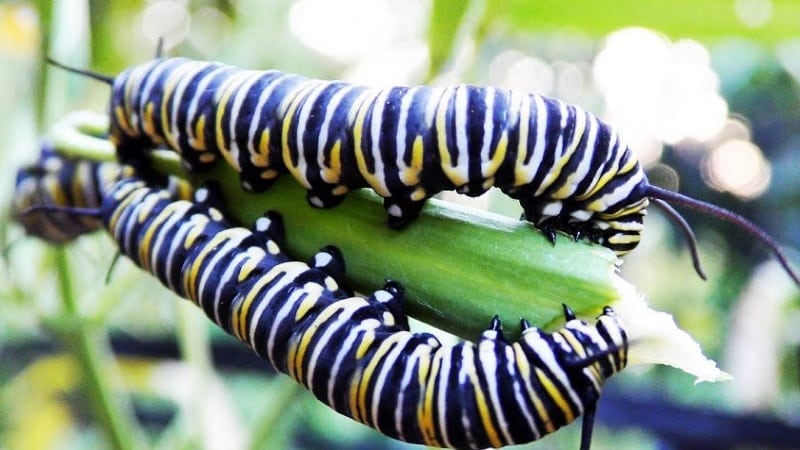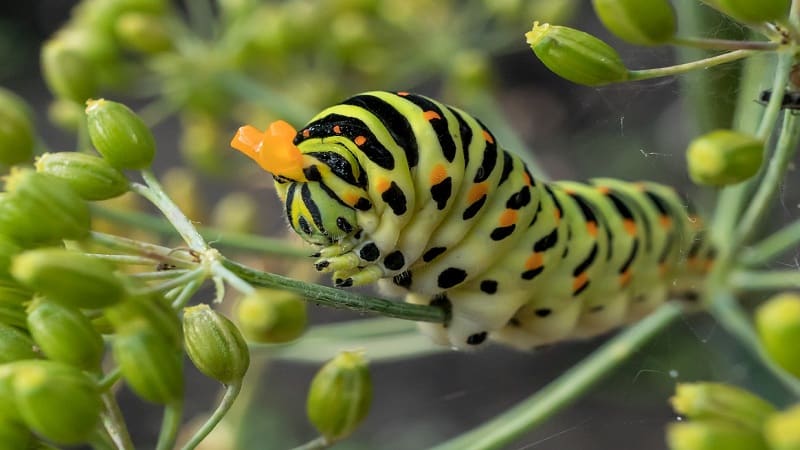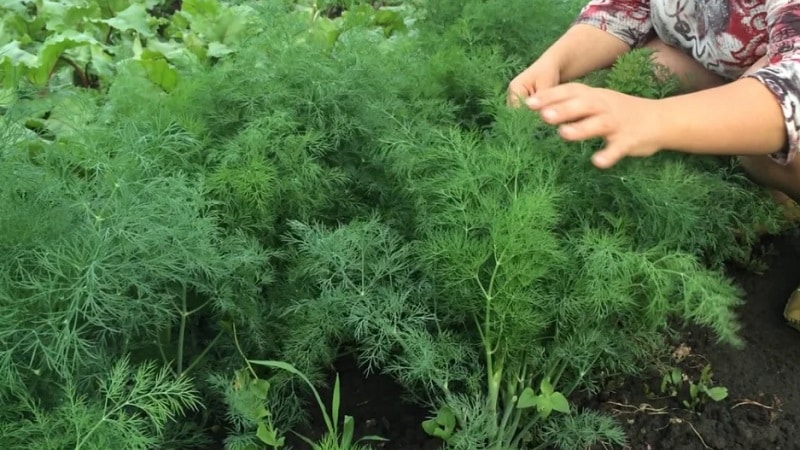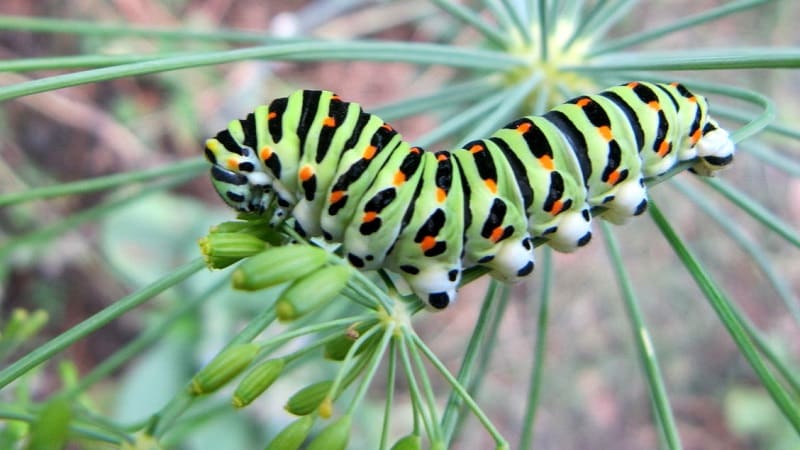How to get rid of caterpillars on dill: the most effective pest control methods
The tender greens of dill attract various sucking insects and caterpillars. Adults are not dangerous to plants and provide aesthetic pleasure to those who enjoy their colorful wings. Caterpillars are voracious and can completely destroy dill if measures are not taken in time. How to get rid of pests using insecticides, biological products and folk remedies?
Types of caterpillars on dill
Juicy dill greens are a real treat for caterpillars. Most often, larvae of swallowtail, umbrella or dill moths, and anise swallowtail butterflies are found on plantings.
Anise swallowtail butterfly
This the insect is ubiquitous. Its distinctive feature is blue spots in the tail. The wingspan is 10 cm. The color is yellow and black.

Green, large caterpillars. Each segment of the body is covered with yellow and black stripes. The pest feeds on tender dill leaves.
Swallowtail
Swallowtail butterfly often found in dill plantings. It is difficult to confuse it with other species. The wings are painted yellow with a black pattern. In the tail part there are areas of blue color. The shades of the wings vary from sand to rich yellow. Color depends on climatic conditions. In the northern regions, the color of the wings is pale, but the black pattern is more pronounced. In the southern regions, swallowtail individuals reach large sizes, the color of the wings is intense yellow, and the black pattern is subtle. The wingspan is 8–9 cm.

The swallowtail caterpillar is also called the green dill caterpillar.. The larvae are large, each section is colored with black and orange specks located along the body.
In just 24 hours, the caterpillar can destroy a bed of dill. In the photo above you can see what kind of butterfly emerges from a swallowtail caterpillar.
It can be useful:
How long does it take for dill to sprout and how to speed up the process
Umbrella moth
Umbrella, or dill, moth - an inconspicuous-looking butterfly with a wingspan of 1.4-1.8 cm. The front wings are dark brown, the leading edge is reddish, and the hind wings are gray.

Larvae appear on dill in the last ten days of May. The body is mustard-beige with brownish dots on each segment. They feed mainly on dill umbrellas, entwining them with a thin web.
Reference. Often, butterflies of one species prefer one or more plants, so caterpillars of other species are rarely found on dill.
Signs of damage and damage caused
The biological task of the caterpillar is to quickly gain weight by feeding on plant tissues.
Signs of defeat:
- eggs and caterpillars on greenery;
- leaf deformation, perforation;
- thin cobwebs on umbrellas;
- sticky liquid.
Without timely treatment, you can be left without dill. The caterpillars have a huge appetite and can quickly destroy dill plantings.
Fighting methods
The following methods are used to kill caterpillars on dill::
- insecticide treatment;
- spraying with biological products;
- folk remedies;
- manual collection;
- attracting birds to the site.

Mechanical removal
Butterflies lay eggs on the back of dill leaves, so weekly planting inspection helps to remove the pest in a timely manner.
Pieces of burlap are used as bait. In hot weather, caterpillars crawl under the fabric, looking for shaded areas. All that remains is to collect the pest and destroy it.
Another effective way to get rid of larvae is installing a bucket of soapy water. The liquid is prepared by eye. Add soap shavings to the water and mix. The dill sprigs are shaken vigorously, the larvae fall into soapy water and die.
Manual collection - the easiest way to remove caterpillars. The swallowtail butterfly is listed in the Red Book, so they cannot be destroyed. It is enough to simply transfer the larvae to fennel, hogweed, angelica, and mustard.
Advice. When collecting caterpillars on the site, do not confuse them with ladybug larvae. They look like small, dark-colored caterpillars with yellow spots and black raised spots on them. The body has 6 legs.

Insecticides
Treating dill with insecticides is not a priority method. Greens are eaten, and chemicals lead to poisoning of the body of varying degrees of severity.
Chemicals are used for large areas of infection and the desire to preserve the harvest at all costs. The safest ones are considered to be “Deci”, “Inta-vir”, “S-30”, “Iskra”. The agents have a paralytic effect, penetrating the digestive tract of insects. Protection lasts from two weeks to two months depending on the product. Manufacturers indicate the dosage and method of use on the packaging. It is important to strictly follow the recommendations and not exceed the permissible dose.
Read also:
Biological methods
When choosing a product for spraying, follow the rule: substances should not accumulate in green mass and be toxic to beneficial insects. The packaging indicates the period during which greens cannot be eaten after processing.
 Biological preparations are suitable for spraying dill “Lepidotsid”, “Biostop”, “Fitoverm”, “Bitoxibacillin”, “Leptotsid”, “Aquarin”, “Entobacterin”, “Aktofit”. They contain the microbe Bacillus thuringiensis, which infects the intestinal tract of the pest, depriving it of the opportunity to feed and blocking access to nutrients.
Biological preparations are suitable for spraying dill “Lepidotsid”, “Biostop”, “Fitoverm”, “Bitoxibacillin”, “Leptotsid”, “Aquarin”, “Entobacterin”, “Aktofit”. They contain the microbe Bacillus thuringiensis, which infects the intestinal tract of the pest, depriving it of the opportunity to feed and blocking access to nutrients.
Biological methods include attracting birds that destroy caterpillars. To do this, feeders and drinking bowls are hung on the site.
To prevent the spread of caterpillars, plants that attract ladybugs and wasps (fennel, marigolds, nasturtium, daisies, asters) are planted next to the dill.
Folk remedies
Herbal infusions and decoctions act as repellents. List of the most effective:
- 400 g of tobacco shag is poured into 10 liters of boiling water and left for 24 hours. Then add 25 ml of liquid soap and begin spraying the plantings. Soap is added to the working solution for better adhesion to the greens.
- 1 kg of pharmaceutical chamomile is poured into 10 liters of boiling water. After 10-12 hours, add 30 g of soap shavings and dilute the concentrated infusion with water in a ratio of 1:3.
- 1 kg of wormwood greens is poured into 3 liters of water and boiled for 30-40 minutes over low heat. After cooling, the volume is adjusted to 10 liters and the dill is generously sprayed.
- 1 kg of yarrow is poured into 10 liters of hot water and left for 1 hour. Then dilute with water 1:1 and leave for 3-4 days. Before spraying, mix in 50 g of soap shavings.
- 1 kg of tomato tops is poured into 10 liters of water and placed on low heat for 1.5 hours.Then the liquid is filtered, diluted with water in a ratio of 1:5 and 50 g of soap shavings are mixed in.
- A 3-liter glass jar is filled 1/3 with onion peels and filled to the top with water. Leave for 2-3 days, filter and add another 5 liters of water. Add 30 g of liquid soap to the liquid.

Preventive measures
Help prevent caterpillars from appearing on dill preventive measures:
- regular inspection of plantings;
- removal of affected inflorescences;
- weeding;
- fertilizing with potassium-phosphorus fertilizers (apply 30 g of potassium salt and superphosphate at the root);
- sowing dill in sunny, well-ventilated areas;
- thinning of plantings;
- compliance with crop rotation;
- covering the dill with thin, breathable agrofibre;
- planting plants that attract beneficial insects.
Conclusion
Caterpillars are often found in dill plantings. Lush and tender greenery attracts specific types of butterflies - swallowtail, dill moth and anise swallowtail butterfly. Their larvae destroy dill in a matter of days. Pest control is most often carried out using infusions and decoctions of herbs, biological products, and traps. Chemicals are used less frequently due to the risk of poisoning with toxic substances. Plants are sown in the areas to attract wasps and ladybugs, and feeders and drinking bowls are hung for birds that feed on caterpillars.
When swallowtail larvae, listed in the Red Book, are found on dill, they are not in a hurry to get rid of them, but are transferred to fennel, hogweed, angelica, and mustard.